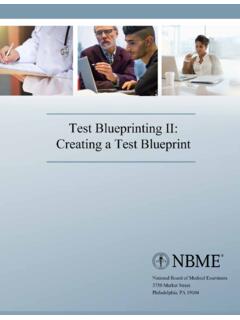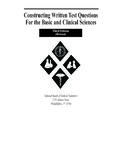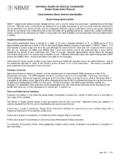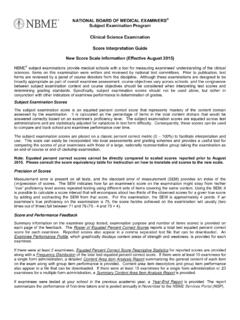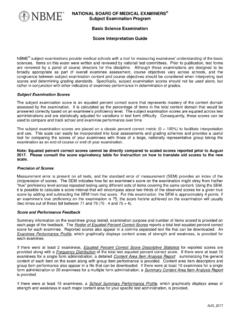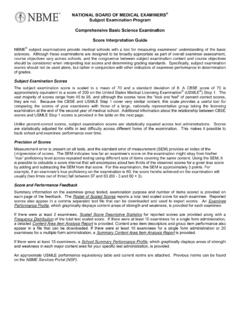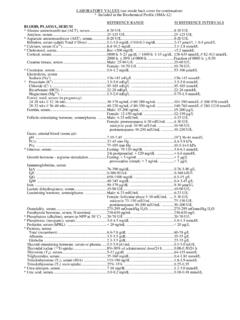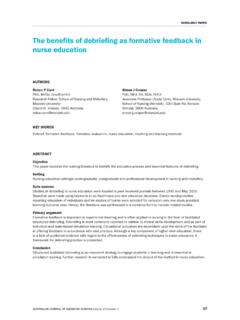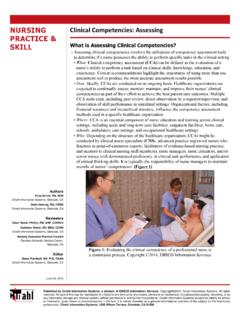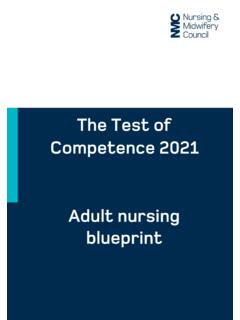Transcription of Test Blueprinting I: Selecting an Assessment Method - NBME
1 Test Blueprinting I: Selecting an Assessment Method . NBME. National Board of Medical Examiners 3750 Market Street Philadelphia, PA 19104. Test Blueprinting I: Selecting an Assessment Method Copyright 2019 National Board of Medical Examiners (NBME ). _____. Test Blueprinting I: Selecting an Assessment Method objectives By the end of this lesson, you should be able to: o Recognize the role of learning objectives in deciding what knowledge and skills to assess o Classify learning objectives according to skill domain (cognitive, affective, and psychomotor). and level of learning (recognition/recall or application/critical thinking). o Consider a wide range of Assessment methods and select a Method that is optimal for the skill being assessed Introduction Consider yourself in the following scenario: You teach an introductory course in clinical diagnosis and want to ensure that your first-year students have mastered auscultation.
2 The previous instructor for the course left you a bank of 70 multiple-choice questions (MCQs) and 20 short-answer questions on auscultation. How would you assess student mastery of auscultation? What Assessment Method would you use? The choice of the optimal Assessment Method will depend on the type of knowledge or skill being assessed and the purpose of the Assessment itself. Factual knowledge about auscultation might be effectively tested with MCQs or other written formats. But when it comes to Assessment of the student's procedural skills, such as properly placing the stethoscope or accurately identifying aortic stenosis when heard, will a set of MCQs still be sufficient? Does this change if the exam has a passing standard and high stakes for the students who fail? In this lesson, you will learn to use a simple framework to ensure the Method of Assessment aligns with the type and purpose of the Assessment .
3 Role of Learning objectives When developing an Assessment , the first step is to identify what you want to assess; these are the learning objectives associated with the test. These are specific, detailed sets of knowledge and skills you expect students to know and be able to do after completing a course. Some examples of objectives that relate to cardiac auscultation are shown below, and you may be able to come up with others: List three causes of aortic stenosis. Offer to and properly drape a female patient prior to auscultation. TEST BLUEPRINT I: Selecting AN Assessment Method 2. _____. Compare and contrast characteristics of a functional systolic murmur and a pathologic murmur. Correctly identify common systolic murmurs on an audio recording. Explain the maneuver for differentiating aortic stenosis from hypertrophic obstructive cardiomyopathy.
4 Perform the maneuver to differentiate aortic stenosis from hypertrophic obstructive cardiomyopathy. Select the most cost-effective Method to evaluate a patient with a suspected heart murmur. Position the patient and transducer and perform an echocardiogram to visualize the aortic valve in the short axis view. The skills described in the objectives are all important. However, keep in mind that these skills are fundamentally different from each other. Some require knowing while others require doing. Cognitive psychologists have come up with multiple frameworks for categorizing skills. You may have heard of Miller's Pyramid, which nicely separates the knowing from the doing (Miller, 1990). It consists of four stages: knows, knows how, shows, and does. This framework can serve as a useful Method to develop and organize a list of learning objectives for a course.
5 Figure 1. Miller's Pyramid TEST BLUEPRINT I: Selecting AN Assessment Method 3. _____. Another useful framework is Bloom's Taxonomy (Bloom, 1956). It comprises three skill domains: Cognitive: knowledge and cognitive skills Affective: attitudes, feelings/emotions, and interpersonal skills Psychomotor: sensory perception and fine and gross motor skills Some learning objectives may involve a single domain. For example, the learning objective of Recognize that the Valsalva maneuver intensifies murmur associated with hypertrophic obstructive cardiomyopathy is primarily cognitive. Other learning objectives may involve all three. For example, the learning objective of Proper placement of the stethoscope requires knowing where to put it and why . covers knowing the placement (cognitive), asking permission from the patient (affective), and then actually placing it (psychomotor).
6 Exercise: objectives and Bloom's Taxonomy For each learning objective, indicate the domain in which it is most associated. Learning Objective Cognitive Affective Psychomotor List three causes of aortic stenosis. Offer to and properly drape a female patient prior to auscultation. Correctly identify common systolic murmurs on an audio recording. Explain the maneuver for differentiating aortic stenosis from hypertrophic obstructive cardiomyopathy. Perform the maneuver to differentiate aortic stenosis from hypertrophic obstructive cardiomyopathy. Position the patient and transducer, and perform an echocardiogram to visualize the aortic valve in the short axis view. TEST BLUEPRINT I: Selecting AN Assessment Method 4. _____. Exercise: Learning objectives and Bloom's Taxonomy Cognitive Domain Because so much of medicine and so much of Assessment involves the cognitive domain, let's explore that further.
7 Bloom proposed six levels within the cognitive domain, where each successive level implies greater depth of learning. These levels are Knowledge, Comprehension, Application, Analysis, Synthesis, and evaluation . These levels were later updated using new terms and a slightly revised order (Anderson, Krathwohl, Airasian, Cruikshank, Mayer, Pintrich, Raths, & Wittrock, 2000); these are Remembering, Understanding, Applying, Analyzing, Evaluating, and Creating. For most Assessment purposes, the lowest two levels (Knowledge/Comprehension or Remembering/Understanding) can be grouped together as a general Recognition and Recall set of tasks, and the remaining four can be grouped together as Application and Critical Thinking.. For each learning objective, indicate the group in which you think it is most associated.
8 Learning Objective Recognition and Recall Application and Critical Thinking List three causes of aortic stenosis. Correctly identify common systolic murmurs on an audio recording. Select the most cost-effective Method to evaluate a patient with a suspected heart murmur. Recognize that the P wave represents atrial depolarization. List the five stages of the cardiac cycle. Explain the position of the AV and semilunar valves at each stage of the cardiac cycle, the status of the ventricles and atria, the pressure differences, and the sounds heard. TEST BLUEPRINT I: Selecting AN Assessment Method 5. _____. Assessment Methods So far in this lesson, the focus has been on the purpose of Assessment and identifying what skills you want to assess. However, there are many different methods of Assessment , for example: o MCQs o Short Answer o Essay Exam o objectives structured clinical Examination (OSCE).
9 O Standardized Patient o Mini- clinical evaluation Exercise (Min-CEX). o Oral Exam o Case-Based Discussion o Chart Stimulated Recall o Portfolios o Chart Audit o Simulators (Harvey, SimMan). o Patient Surveys o 360-degree Feedback o Direct Observation The following graphic shows some of these methods ordered on the continua of fidelity (how similar the Assessment format is to the actual work-related task) and reliability (how replicable the test scores are across assessments). Figure 2. Continuum of Some Assessment Methods. TEST BLUEPRINT I: Selecting AN Assessment Method 6. _____. There are a number of differences between the Assessment methods as we move along the continuum: 1. The methods on the left better assess knowing, while the methods on the right better assess doing. 2. The methods toward the left tend to be quick and efficient to develop and score, while the methods toward the right tend to be more costly and/or time-consuming.
10 3. The methods toward the right are more realistic, because they reproduce the natural environment with greater fidelity and are more likely to elicit the clinical skills of most interest for Assessment . Unfortunately, this fidelity comes with a trade-off, as these also tend to produce less reliable scores. The continuum of Assessment methods can also be grouped into three broad categories: Written exams: for example, MCQs, essays Simulations: for example, standardized patients, OSCEs, and oral exams (these methods simulate the cognitive, affective, or psychomotor skills required in the practice setting). Workplace assessments: for example, 360-degree feedback (evaluations that take place during actual practice). Putting It All Together When developing an Assessment Method for a given skill or set of knowledge, the purpose of the test and the type of skills to be assessed are the two most important factors.
